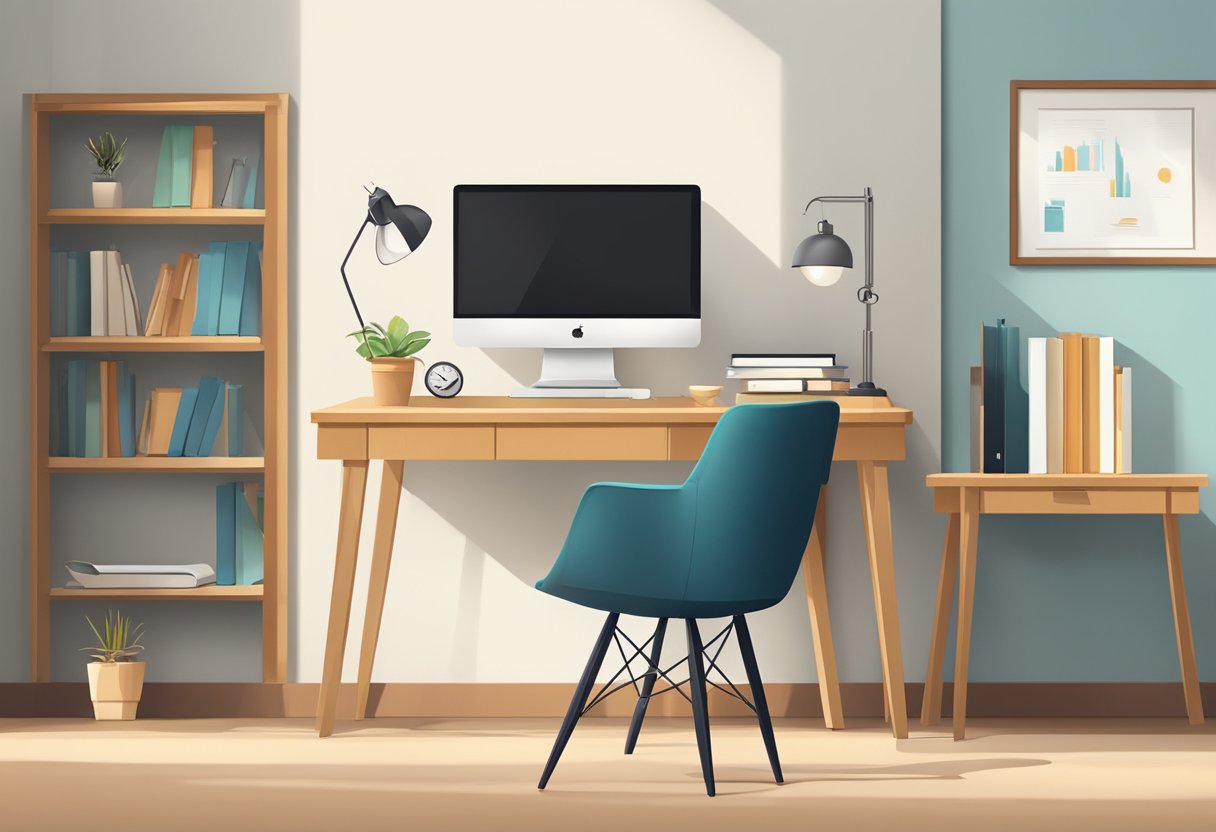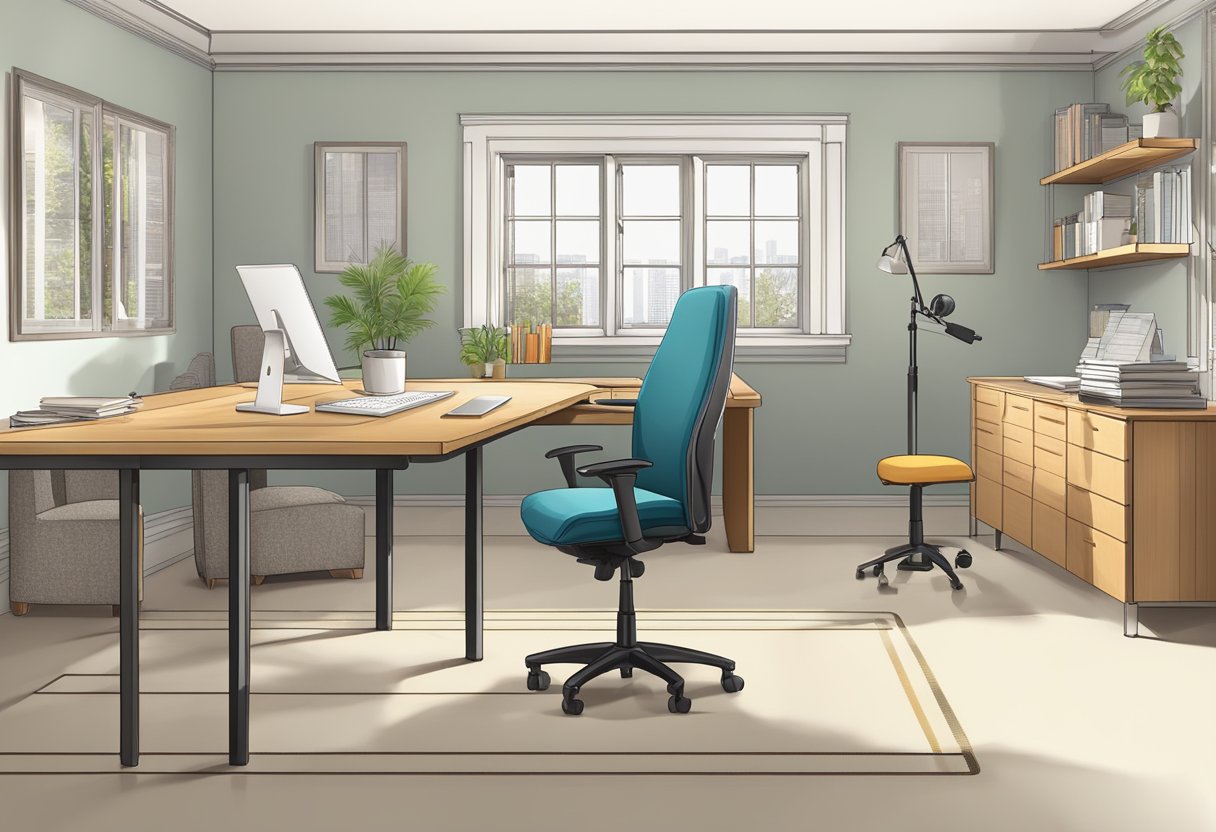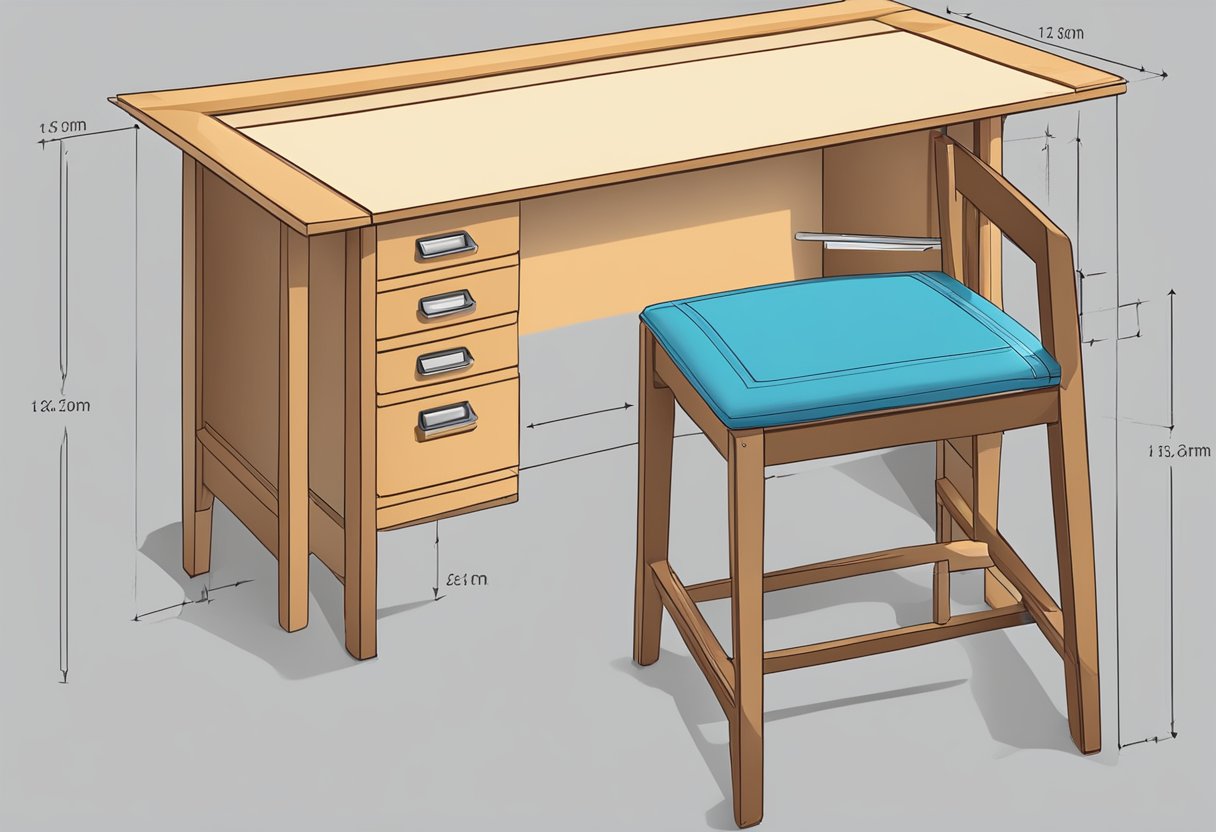- You are here:
- Home »
- Desk Tips »
- What is the Correct Height for a Desk? A Comprehensive Guide
What is the Correct Height for a Desk? A Comprehensive Guide
As an Amazon Associate I earn from qualifying purchases.
When it comes to setting up your workspace, one of the most important factors to consider is the height of your desk. The correct desk height can have a significant impact on your comfort, health, and productivity throughout the day. But what is the correct height for a desk, and how do you ensure that your workspace is set up optimally for your needs?

Understanding ergonomics is key to finding the right desk height. Ergonomics is the science of designing and arranging objects in the environment to fit the human body’s needs and capabilities. An ergonomic workspace aims to minimize the risk of injury and strain while maximizing comfort and efficiency. In this article, we’ll explore the optimal setup for health and productivity, as well as the various factors to consider when choosing the right equipment for your workspace.
Key Takeaways
- The correct desk height is crucial for your comfort, health, and productivity.
- Ergonomics is the science of designing a workspace that fits the human body’s needs and capabilities.
- To find the right desk height, consider factors such as your body proportions, tasks, and equipment, and aim for an ergonomic setup that minimizes the risk of injury and strain.
Understanding Ergonomics
https://www.youtube.com/watch?v=DJ54MVfkGRg&embed=true
The Importance of Ergonomics
When it comes to designing a workspace, ergonomics is an essential factor that should not be overlooked. Ergonomics is the science of designing equipment, tools, and workstations that fit the user’s body and movements, ensuring maximum comfort, productivity, and safety. A well-designed ergonomic workspace can help reduce the risk of injuries, improve posture, and increase productivity.
Ergonomic Principles
Ergonomic principles are guidelines that help ensure that a workstation is ergonomically correct. The following are some of the essential ergonomic principles that should be considered when designing a workspace:
Desk height: The desk height should be such that your elbows are at a 90-degree angle and your forearms are parallel to the ground. This helps reduce strain on your upper arms and shoulders.
Chair height: The chair height should be such that your feet are flat on the ground, and your thighs are parallel to the ground. This helps reduce strain on your lower back.
Posture: Maintaining good posture is critical to reducing strain on your spine. Your back should be straight, and your shoulders should be relaxed.
Workspace: The workspace should be organized in such a way that you don’t have to strain to reach anything. This helps reduce strain on your shoulders and upper arms.
Keyboard and mouse: The keyboard and mouse should be at a comfortable distance from your body, and your wrists should be straight. This helps reduce the risk of wrist pain.
Monitor height: The monitor should be at eye level, and your ears should be in line with your shoulders. This helps reduce strain on your neck.
By following these ergonomic principles, you can create an ergonomically correct workspace that reduces the risk of injuries, improves posture, and increases productivity. If you’re unsure about the correct ergonomic desk height for you, you can consult resources such as the Mayo Clinic or Desk Advisor to help you determine what works best for your body proportions.
The Right Desk Height
https://www.youtube.com/watch?v=cMKCCKjphgs&embed=true
When it comes to setting up your workspace, one of the most important factors to consider is the height of your desk. A desk that is too high or too low can lead to discomfort and even injury over time. In this section, we’ll explore the correct desk height for both sitting and standing positions.
Desk Height for Sitting
If you spend most of your workday sitting at your desk, it’s important to make sure your desk is at the right height to avoid strain on your back, neck, and shoulders. The ideal desk height for sitting should allow you to sit with your feet flat on the ground and your knees at a 90-degree angle.
To determine the correct desk height for you, measure the distance from the floor to your elbow while your arms are bent at a 90-degree angle. This measurement will give you a good starting point for finding the right desk height. If your desk is not adjustable, you may need to adjust your seat height or use a footrest to achieve the correct posture.
Desk Height for Standing
Standing desks have become increasingly popular in recent years, as more people look for ways to reduce the amount of time they spend sitting. If you’re using a standing desk, it’s important to make sure the desk is at the correct height to avoid strain on your back, neck, and shoulders.
The ideal desk height for standing should allow you to stand with your feet flat on the ground and your elbows at a 90-degree angle. If your desk is adjustable, you can experiment with different heights to find the most comfortable position for you. It’s also important to take breaks and stretch regularly when using a standing desk to avoid fatigue and discomfort.
In summary, the correct desk height is essential for maintaining good posture and avoiding discomfort and injury. Whether you’re sitting or standing, make sure your desk is at the right height for your body proportions. If you’re using an adjustable desk, take the time to experiment with different heights to find the most comfortable position for you.
Optimal Setup for Health and Productivity

When it comes to setting up your desk, there are a few key factors to consider to ensure both your health and productivity are maximized. Below are the two main areas to focus on when setting up your workspace:
Monitor and Keyboard Placement
Proper monitor and keyboard placement is crucial to avoiding strain and fatigue. Your monitor should be positioned directly in front of you at eye level to prevent neck and eye strain. If you use a laptop, consider using a laptop stand to raise the screen to eye level. Your keyboard should be positioned at a comfortable distance from your body, with your elbows bent at a 90-degree angle and your shoulders relaxed. Consider using a keyboard tray to achieve the correct height and tilt.
Chair and Posture
Your chair and posture play a significant role in your overall comfort and health while working. Choose an adjustable chair with armrests that can be adjusted to the correct height and tilt. Your feet should be flat on the ground, and your knees should be at a 90-degree angle. Use seat cushions or adjust the chair height to achieve the correct posture. Avoid slouching or leaning forward, as this can cause strain on your neck and back.
By tailoring your equipment and workspace to your tasks and fitness level, you can optimize your health and productivity while working. Remember to take breaks and stretch periodically to avoid fatigue and strain on your body. With these tips, you can create a workspace that works for you.
Choosing the Right Equipment

When it comes to setting up your workspace, choosing the right equipment can make a big difference in your comfort and productivity. Two key pieces of equipment to consider are your desk and chair. Here’s what you need to know to choose the right ones for you.
Choosing a Desk
The height of your desk is important to ensure that you maintain good posture and avoid discomfort. The standard desk height is around 29 inches, but this may not be the best height for everyone. If you’re taller or shorter than average, you may need a desk that’s higher or lower than this.
An adjustable desk is a great option if you want to be able to switch between sitting and standing throughout the day. These desks can be adjusted to different heights, so you can find the perfect height for both sitting and standing.
If you prefer a traditional seated desk, make sure it’s the right height for you. You should be able to sit with your feet flat on the ground and your arms at a comfortable angle to the keyboard. If your desk is too high or too low, you may need to adjust your chair or use a footrest to maintain good posture.
Choosing a Chair
Your chair is just as important as your desk when it comes to comfort and posture. Look for an ergonomic chair that supports your back and encourages good posture. An adjustable chair is ideal, as you can adjust the height and angle of the seat and backrest to suit your needs.
If you prefer to work on a laptop, consider using a laptop stand to raise the screen to eye level. This can help to reduce neck and shoulder strain.
When choosing a chair, make sure it’s the right height for your desk. You should be able to sit with your feet flat on the ground and your arms at a comfortable angle to the keyboard. If your chair is too high or too low, you may need to adjust your desk or use a footrest to maintain good posture.
By choosing the right desk and chair for your needs, you can create a comfortable and ergonomic workspace that supports your productivity and wellbeing.
Frequently Asked Questions

What is the recommended height range for a desk?
The recommended height range for a desk is between 28-30 inches (71-76 cm) for seated work. This height range is suitable for most people who are of average height (around 5’8″ or 173 cm). However, if you are taller or shorter than average, you may need to adjust your desk height accordingly.
What height should an adjustable desk be set to?
An adjustable desk should be set to a height that allows you to work comfortably. The ideal height for an adjustable desk is between 28-46 inches (71-117 cm) for seated work, depending on your height. When standing, the desk should be at a height that allows your arms to rest comfortably at a 90-degree angle.
What is the ideal desk height for someone who is 5’3?
For someone who is 5’3, the ideal desk height would be between 25-27 inches (63-68 cm) for seated work. However, it is important to note that everyone is different, and some people may find that a slightly higher or lower desk height is more comfortable.
How do I use an ergonomic desk height calculator?
To use an ergonomic desk height calculator, you will need to input your height and arm length. The calculator will then provide you with a recommended desk height range for seated and standing work. However, it is important to note that these calculators are just a guide, and you may need to adjust your desk height based on your personal preferences and comfort.
What is the best desk height for someone who is 6 feet tall?
For someone who is 6 feet tall, the ideal desk height would be between 30-32 inches (76-81 cm) for seated work. However, as mentioned earlier, everyone is different, and some people may find that a slightly higher or lower desk height is more comfortable.
What is the recommended standing desk height?
The recommended standing desk height is between 39-48 inches (99-122 cm) for most people. However, it is important to note that standing for long periods of time can be tiring, so it is recommended to alternate between sitting and standing throughout the day.
Amazon and the Amazon logo are trademarks of Amazon.com, Inc, or its affiliates.
Related Posts
03 Dec, 2023Home File Organization Categories: A Comprehensive Guide
03 Dec, 2023How to Organize Papers Without a Filing Cabinet: Simple Tips and Tricks
03 Dec, 2023Does a Corner Desk Have to Be in a Corner? Exploring the Placement Options
03 Dec, 2023How to Organize a Desk Without Drawers: Tips and Tricks
21 Nov, 2023Ergonomic Height for Desk: How to Set it Up for Optimal Comfort and Health

